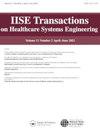多模态医学数据的鲁棒耦合张量分解和特征提取
IF 1.5
Q3 HEALTH CARE SCIENCES & SERVICES
IISE Transactions on Healthcare Systems Engineering
Pub Date : 2022-10-31
DOI:10.1080/24725579.2022.2141929
引用次数: 0
摘要
在医学领域的各个领域中,用于描述患者临床状况各个方面的高维和多模态数据变得越来越丰富。例如,在神经成像应用中,可以同时收集脑电图(EEG)和功能磁共振成像(fMRI)(即EEG-fMRI),以提供患者大脑功能的高空间和时间分辨率。此外,在远程监控应用中,智能手机可以通过内置麦克风、加速度计、触摸屏等记录患者病情的各个方面。耦合CANDECOMP/PARAFAC分解(CCPD)是一种从多个张量中同时提取共同结构和特征的强大方法,可以应用于这些高维、多模态数据。然而,现有的CCPD模型不足以处理在这两种应用中高度存在的异常值。对于EEG-fMRI,由于EEG电极和fMRI机器之间的干扰导致的电磁场波动,异常值是常见的。对于远程监测,异常值可能是由于患者在家中进行智能手机指导的锻炼时没有正确遵循指导。这促使我们提出一种鲁棒CCPD (RCCPD)方法来进行鲁棒特征提取。该方法利用乘数交替方向法(ADMM)最小化目标函数,同时分解一对耦合张量并隔离异常值。将RCCPD方法与经典CP分解、耦合矩阵-张量/张量-张量分解(CMTF/CTTF)和张量鲁棒CP分解(TRCPD)进行了比较。在合成数据和实际数据上的实验表明,所提出的RCCPD有效地处理了异常值,并且在准确性方面优于基准。本文章由计算机程序翻译,如有差异,请以英文原文为准。
Robust coupled tensor decomposition and feature extraction for multimodal medical data
Abstract High-dimensional and multimodal data to describe various aspects of a patient’s clinical condition have become increasingly abundant in the medical field across a variety of domains. For example, in neuroimaging applications, electroencephalography (EEG) and functional magnetic resonance imaging (fMRI) can be collected simultaneously (i.e., EEG-fMRI) to provide high spatial and temporal resolution of a patient’s brain function. Additionally, in telemonitoring applications, a smartphone can be used to record various aspects of a patient’s condition using its built-in microphone, accelerometer, touch screen, etc. Coupled CANDECOMP/PARAFAC decomposition (CCPD) is a powerful approach to simultaneously extract common structures and features from multiple tensors and can be applied to these high-dimensional, multi-modal data. However, the existing CCPD models are inadequate to handle outliers, which are highly present in both applications. For EEG-fMRI, outliers are common due to fluctuations in the electromagnetic field resulting from interference between the EEG electrodes and the fMRI machine. For telemonitoring, outliers can result from patients not properly following instructions while performing smartphone-guided exercises at home. This motivates us to propose a robust CCPD (RCCPD) method for robust feature extraction. The proposed method utilizes the Alternating Direction Method of Multipliers (ADMM) to minimize an objective function that simultaneously decomposes a pair of coupled tensors and isolates outliers. We compare the proposed RCCPD method with the classical CP decomposition, the coupled matrix-tensor/tensor-tensor factorization (CMTF/CTTF), and the tensor robust CP decomposition (TRCPD). Experiments on both synthetic and real-world data demonstrate that the proposed RCCPD effectively handles outliers and outperforms the benchmarks in terms of accuracy.
求助全文
通过发布文献求助,成功后即可免费获取论文全文。
去求助
来源期刊

IISE Transactions on Healthcare Systems Engineering
Social Sciences-Safety Research
CiteScore
3.10
自引率
0.00%
发文量
19
期刊介绍:
IISE Transactions on Healthcare Systems Engineering aims to foster the healthcare systems community by publishing high quality papers that have a strong methodological focus and direct applicability to healthcare systems. Published quarterly, the journal supports research that explores: · Healthcare Operations Management · Medical Decision Making · Socio-Technical Systems Analysis related to healthcare · Quality Engineering · Healthcare Informatics · Healthcare Policy We are looking forward to accepting submissions that document the development and use of industrial and systems engineering tools and techniques including: · Healthcare operations research · Healthcare statistics · Healthcare information systems · Healthcare work measurement · Human factors/ergonomics applied to healthcare systems Research that explores the integration of these tools and techniques with those from other engineering and medical disciplines are also featured. We encourage the submission of clinical notes, or practice notes, to show the impact of contributions that will be published. We also encourage authors to collect an impact statement from their clinical partners to show the impact of research in the clinical practices.
 求助内容:
求助内容: 应助结果提醒方式:
应助结果提醒方式:


